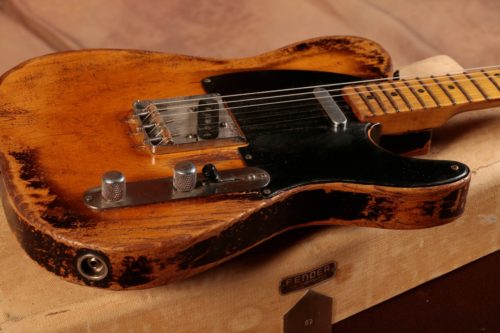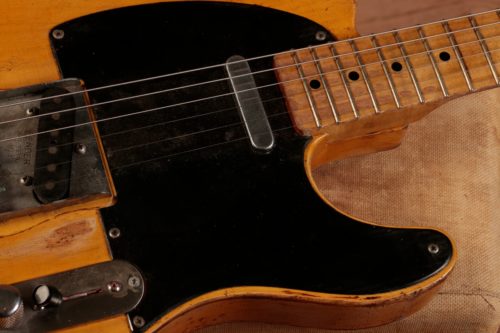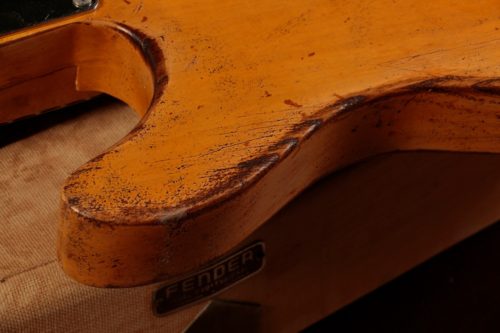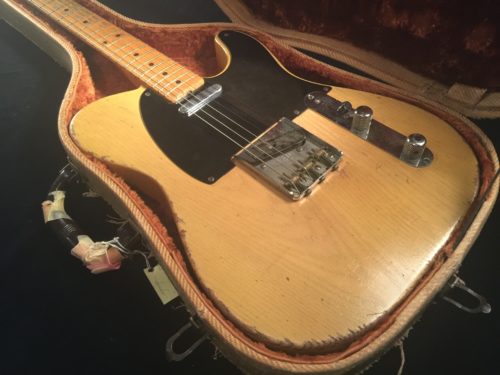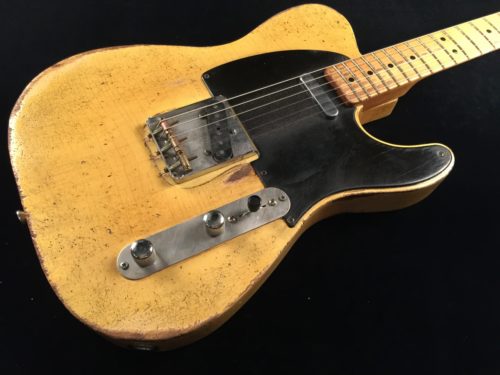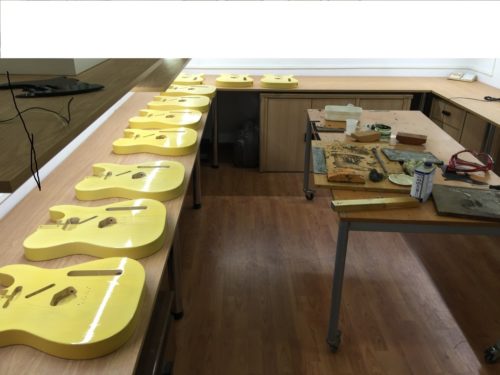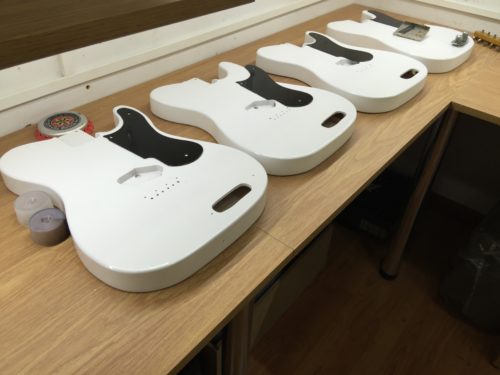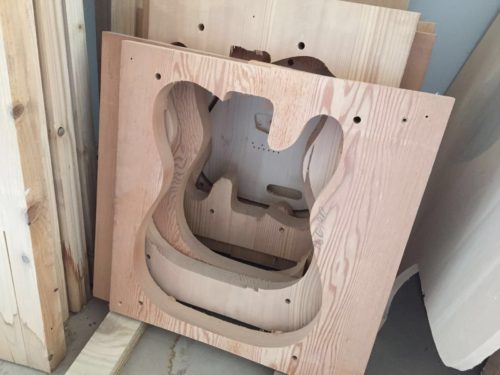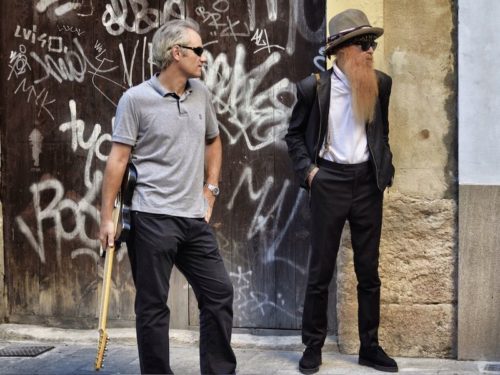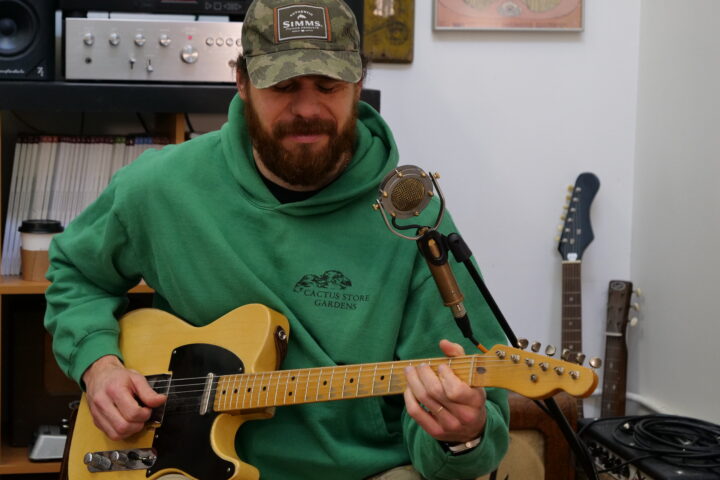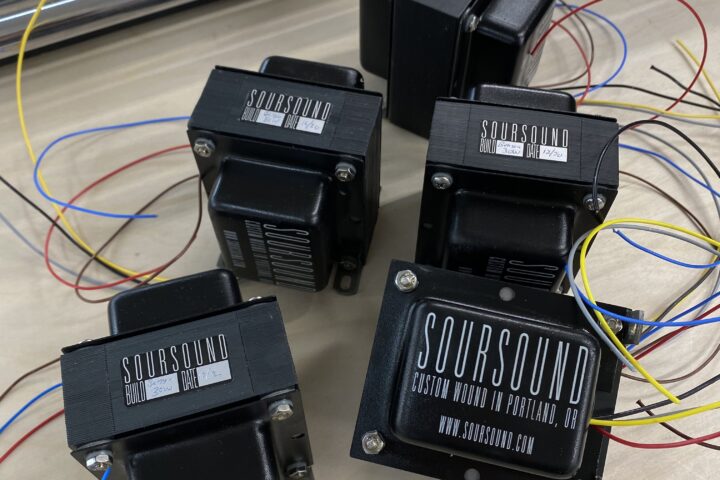Obsessing over classic guitars is nothing new – it’s more or less central to our job description and probably a big part of why most of you are reading this. Focusing that obsession on Leo Fender’s creations from the 1950s isn’t particularly novel, either, and you’d quickly run out of digits to count on tallying the builders who cite those instruments as inspiration. Ignacio Baños, however, takes it beyond pretty much anyone who’s not on a bench at the Fender Custom Shop. Starting as a collector drawn to blackguard Telecasters, “Nacho” has turned his fanaticism into a business building “flawless” reproductions of his favorite guitars – Nachoguitars – starting with those blackguards and including classic Teles from the mid-‘50s and, recently, Stratocasters, too. Really, how could we avoid talking to him for a Bench Press?
Fretboard Journal: So the obvious question, what do you think it is about ‘50s Fenders that makes them such iconic, amazing instruments?
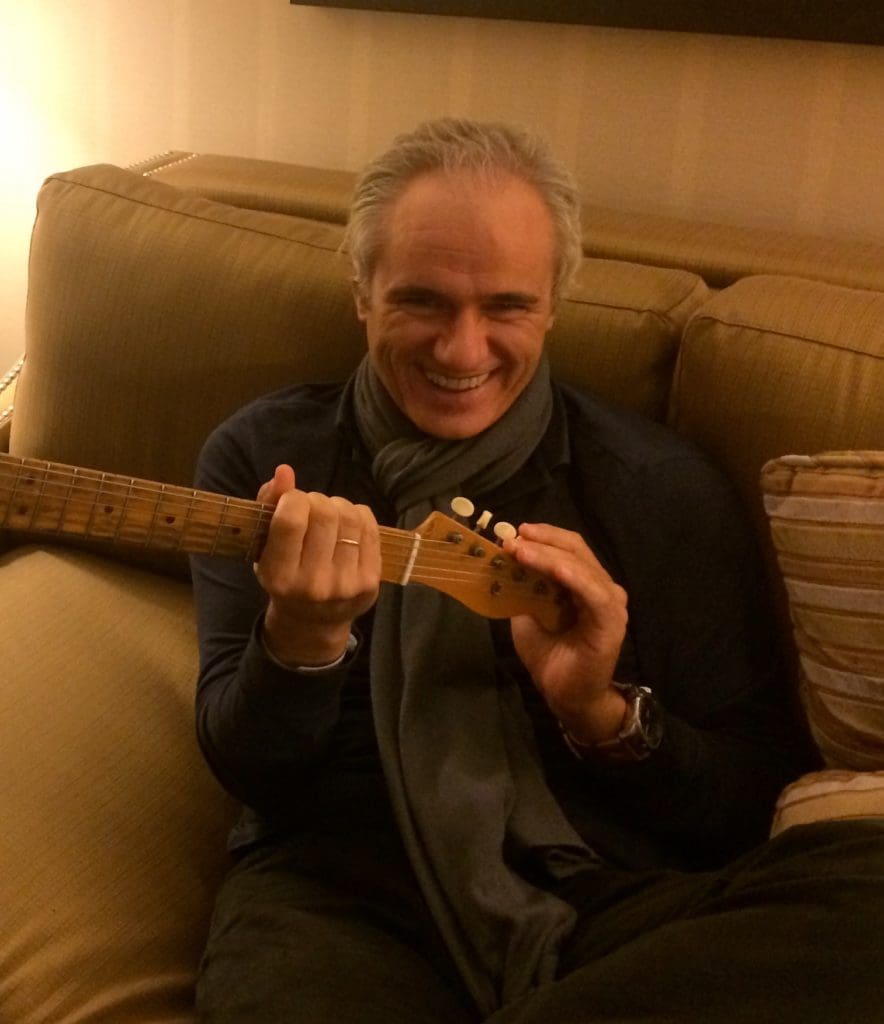
Ignacio Baños: I believe Leo may not have been the first, but he came up with a perfect formula from Day One. Elvis did not invent rock and roll when Sam Phillips rolled the tape at 706 Union Avenue in Memphis in 1954, but he took all kinds of different ingredients combined – from gospel, blues and country – to make them sound fresh, new and exciting for a whole new generation. You just need to listen to the originals and compare. He was a young white kid twisting Arthur Crudup’s blues numbers on prime-time national television with teenage girls screaming in the audience. He came up with a different formula for something that had been out there for a long time.
Leo was not the first to create a Spanish solid body electric guitar but his innovative recipe was an immediate, massive success. His goal was to come up with a high quality reliable axe to reproduce the sweet sounds of the steel guitar without feeding back, mass-produced in a cost-effective manner. He could not play a note but he was very aware of musicians’ needs. He kept field testing and refining his product. His approach was total quality 40 years before that concept was even invented. And while competitors were making guitars very much like violins, he came up with a groundbreaking modular product with easily interchangeable parts. Think IKEA versus classic furniture manufacturing. New World versus Old World. Some folks laughed at those weird-looking artifacts, calling them canoe paddles. That is natural human fear and resistance to change. It is like fighting the train with bows and arrows. I believe the Pop era really took off with blackguard Fenders in the 1950s.
There are many innovative ideas combined in a primitive Broadcaster which we may take for granted today. Bolt-on solid maple neck on a solid wood body, six tuners on a side, waterslide decal, detachable hardware and pickups, bridge plate with adjustable saddles… Just like the best things in life, like a great Beatles song – simple, functional, beautiful and very effective.
I went into the studio a couple weeks ago to record three new songs. This is a state of the art studio in Valencia, my hometown in Spain. The Gibbons were on vacation visiting for a few days. After some quick brainstorming Billy and I decided to take a 1950 Broadcaster and 1951 Esquire, backed up by a 1956 and 1958 Bassman. Of all of the things we had access to, and believe me, we had access to some, those were hands down the absolute best choices for the job. I just believe that’s pretty darn amazing. As if a 1930s Ford Model T was the best choice for a pilot to race the Formula 1 Grand Prix in Austin this year.
Leo’s creations were timeless classics from the day they were born and they are as modern and contemporary today as they were 65 years ago.
FJ: There are some infamous quirks (stamps, etc.) on those early Fenders that nobody has been able to decipher. Do you have any favorites, and any theories?
IB: My day job routine involves tooling and houseware products manufacturing. There are different processes involved before you reach the final product completion. Quality control and trackability systems are applied to assure every step of the way is correctly executed, so if problems arise they can be clearly identified, analyzed and solved in the most aseptic manner. The production marks you mention were quality control checks. Different people were performing different tasks that were identified by a date, a signature, a stamp… this way if something went wrong they could easily track it down and determine the simplest way to solve it. Gloria, Virginia and Mary were soldering and dating wiring harnesses. If a wiring problem was found in a given guitar, the controller could easily identified who and when the soldering job was completed and decide to check the whole production batch made on that date by that particular worker. The same applied to Charlie Davis, Tadeo Gomez and Eddie Miller when they signed and dated bodies and necks. I am not sure what the D stamp stands for, but I believe it is an initial check. Some worker (Paul Dallmeir?) was stamping/approving wood and metal parts before they went into the finishing/lacquering/plating process. It makes a lot of sense to make sure no extra process costs were added on top of already flawed components.
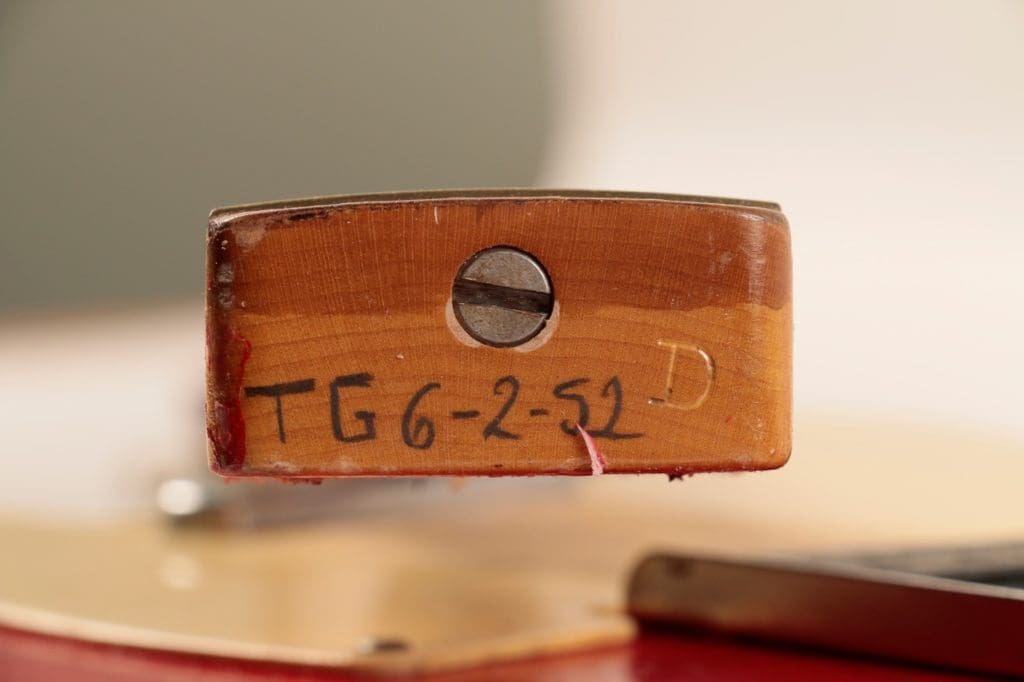
FJ: Can you tell us a little bit about how you choose the dates and names for the neck, neck pocket, and control cavity?
IB: I started using all the names from the women at the wiring section at Fender during the 1950s (Gloria, Virginia, Barbara, Mary, Eleanor…), but I ran out of those pretty soon, so I used all the women’s names in my family – I have four daugthers and seven nieces! Then I went looking for other cool names on the internet. I would Google things like “rock star’s wives,” “cool women’s names,” “cool Southern names…”
I am a big Southern rock fan and there are many great women’s names on some of those songs…Laura Mae, Brenda, Aura Lee, Rita, Lynda Lou, Sara Joe, Mary Anne, Roselynn, Louise, Maggie, Nadine, Abigail, Loretta, Theodora, Anna Beth…
When somebody buys a guitar from me they can also choose the name they like. Some people like to name guitars after their wives, girlfriends, daughters… It’s like, “Yes honey, I bought another guitar but it’s named after you!”
I still have some leftover stock of original copies of the Blackguard book, so I stamp bridge plates with matching numbers of the books. This way you can have a copy of the book and the guitar with the same serial. Some people like to choose a special serial number for a birthday, anniversary, etc… The type of client looking for a very specific high quality replica guitar is very much into details, and I believe these are nice additions to the package.
FJ: There’s kind of a “Holy Trinity” at the center of Nachoguitars – Look, Feel, Tone – how do those three things interrelate?
IB: Good tone is a fairly subjective concept affected by many different variables, the pickups and amplifier you use being the most important. Of course your hands, the way you play, will be critical in putting those variables to work.
A musical instrument is just a tool to express, to communicate your inner soul with the outside world. We all use similar tools but express ourselves in many different ways. How you are as a person will determine the way you interact with your environment. A musical instrument will only channel your personality.
Everybody has a different idea of what a Holy Grail-sounding guitar should be. That is the reason why I don’t take custom orders. I just make my own version, a standard product which is in fact kind of my homage to some of the best genuine vintage instruments I have owned and played in my life. I just use my experience to make those guitars and put them out for sale.
I have been obsessed with vintage guitars for almost 30 years. I bought my first vintage Telecaster in 1989 and I have played vintage instruments solely ever since. The sound, feel, looks… even the smell of old vintage electrics is encrusted in my DNA. I can even tell the year in which those thermometer and poodle cases were made just by looking at the covering. I would like to think I imprint that passion into every guitar I ship out.
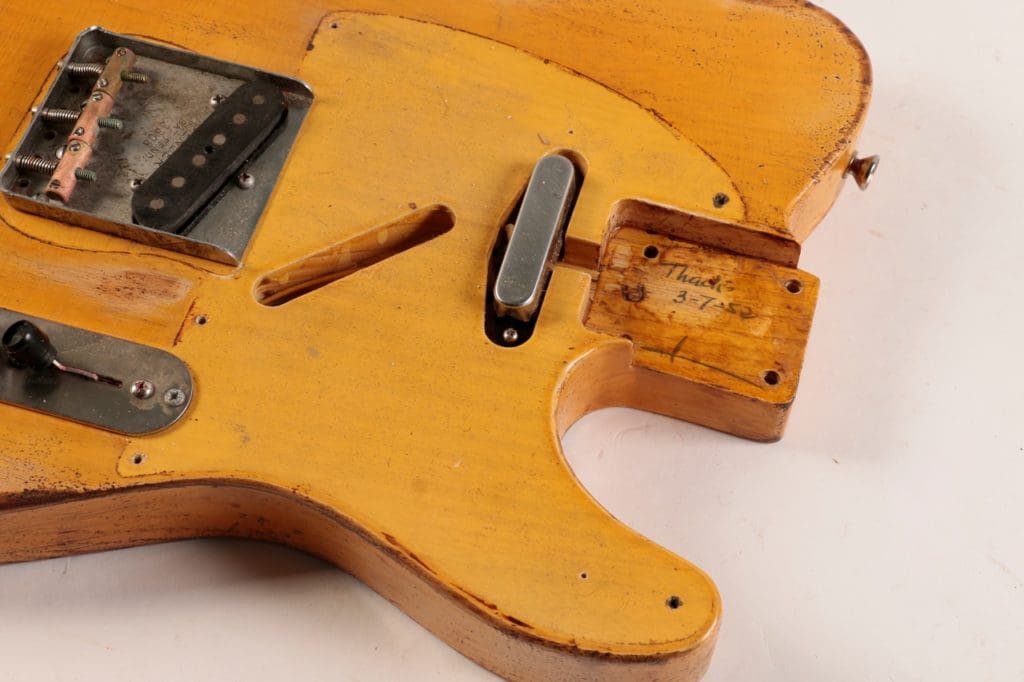
I believe it’s key to use the correct elements to achieve a correct vintage look and feel. The finish is the skin of the instrument and will have the most important effect on the feel. I have been analyzing old lacquers for years and came up with my own nitro formula. A good nitro finish will age in a very nice vintage way and this will make the guitar feel old if you take the time to age it right.
I use original vintage guitars as reference models for aging. I don’t put random marks but instead I replicate real scars found on genuine vintage instruments. This takes a heck of a lot more time but the results are much more convincing. It’s not just about the looks, it is the overall feel from a guitar that has been lacquered and aged in a certain manner.
Aging a guitar properly requires a lot of effort, so before you start putting all those long hours you need to make sure you are bidding on the right horse. Of course you need correct routing profiles and contour specs. Good frets, nut, bridge plate and saddles, neck and body fit… all those details are very important. A bolt-on solid body electric will never feel great if those key ingredients are not well accounted for.
I have found large necks and lightweight bodies to be a way-to-go formula for great tone. I make bodies and necks in different batches. Once they are completed I put time into finding the best neck fit for each body. It’s like pairing couples. I match them so the resonating properties are enhanced.
The lacquer composition and the number of coats to achieve the ideal thickness and realistic color shade is the icing on the cake.
Once the guitar is finished you just need time to age it right. We all know you cannot polish a turd but time takes a good toll on well made musical instruments. It makes them better. The key is to compress 60 years of wear and tear into just a few months of friendly abuse.
The best compliment I receive from my customers is my guitars feel and sound old. That is my main goal. Like having a time machine to go back in time and replicate every process in the same way it was done 65 years ago. To reproduce the passing of time and achieve results which faithfully recreate not only the looks but the feel and vibe of a vintage instrument. I am always willing to walk the extra mile to get closer to this goal. And I keep trying to improve with every new batch that I make.
Some people have expressed their concerns with the level of detail I show in my instruments. I would like to point out that my guitars are tribute, homage pieces to the legendary originals and I keep a very respectful approach in everything I do. The shapes and contours are close but not exactly those found in real vintage examples. The routs have different shapes, depth and dimensions. I sign my name in guards, bridges and body cavities. So in case you had any doubts at first glance, all you need is five minutes and a screwdriver to tell a Nachoguitar from a 65-year old genuine vintage treasure.
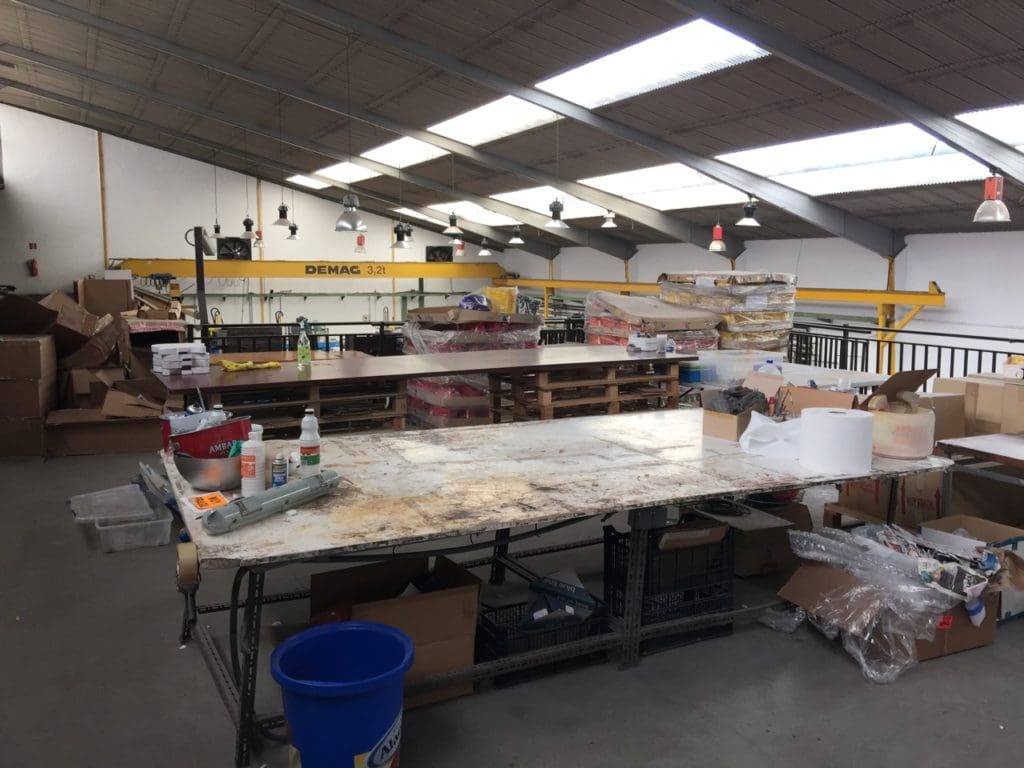
FJ: Can you tell us about the materials and components you’re using?
IB: I am using stuff from different sources.
Some people don’t know about this but the weather conditions in Paterna (where my work shop is located, a small industrial town near Valencia, Spain) make this city one of the most ideal places to work with guitar woods. Maderas Barber, one of the largest wood suppliers for musical instruments in Spain, is located only five minutes away from my place.
For wood parts I try to keep it simple and stick to early 1950s specs, but lately I have been experimenting with different combinations to make bodies with different specs. As part of my research work for my upcoming book on primitive electric guitars, I have had access to some early 1949-50 prototypes. So I am now also offering pinewood sandwich hollow-bodied guitars.
I get most of my hardware from WD in USA and Hosco in Japan. I use correct composition phenolic material for my guards. I source all my lacquers from local suppliers in Spain.
I just started sourcing cases from G&G in California.
For pickups I am following the specs obtained from my research work on the Blackguard book, which has been published since 2005.
I use Switchcraft jacks, CRL switches, Mec and CTS pots. For caps I started making my own CD replicas a while back, but now I am using Luxe and a batch of Russian NOS I bought years ago.
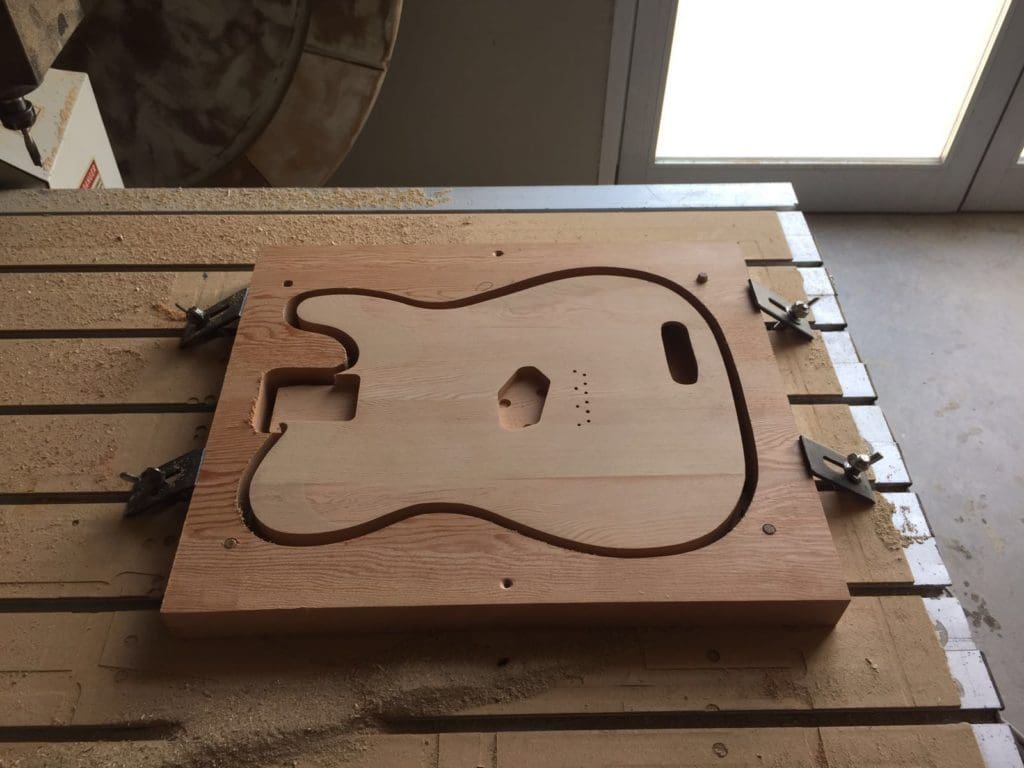
FJ: Pinewood sandwich guitars? What can you tell us about that project?
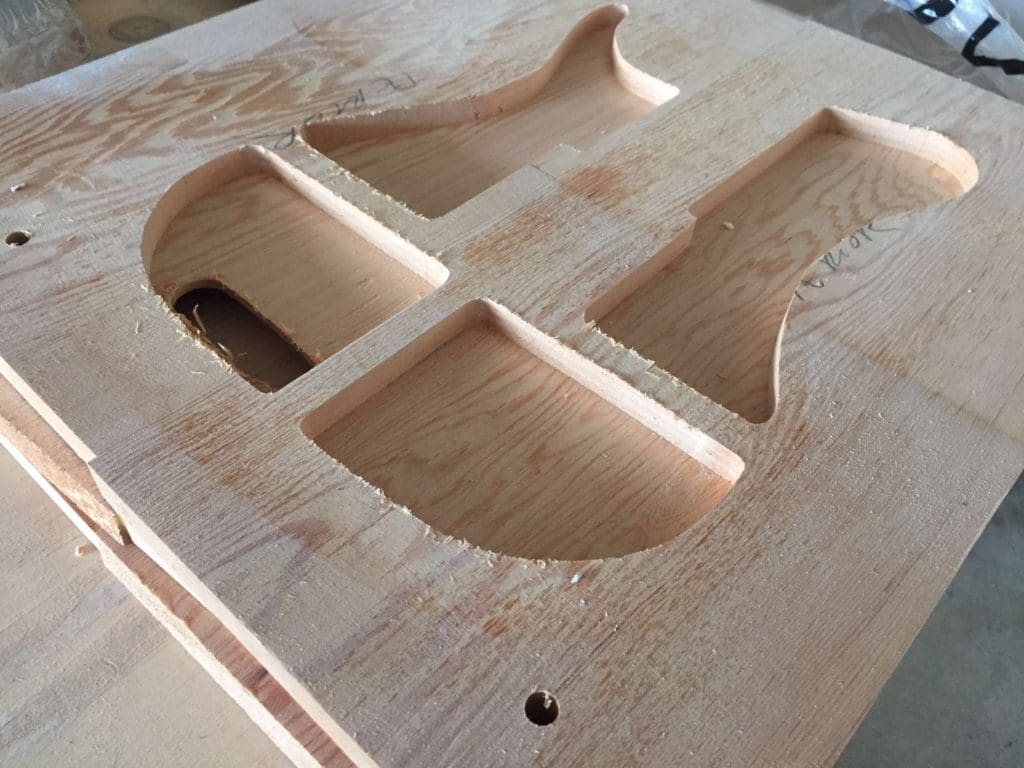
IB: As part of the pinecaster book research project I have had access to a few pine guitars made by Leo during 1949-1950. After taken all the specs I have decided to build a first run of “Prototype 2” guitars with a sandwich chambered body and a neck with a truss rod. The original guitar is pretty amazing and I’m trying to go all the way into replicating it – I’m even taking the same finish journey: It was initially white (like Prototype 1), then painted red over the white, then stripped and clear coated. I have the necks ready and five bodies are a work in progress – I’m in the process of stripping the red and white now… I’m even cutting the lap steel tuners just like he did with the two first guitars. The pickup is made of red forbon with no metal elevator plate. It sings in a different key!
FJ: Personally, I obsess about necks – I’m a firm believer in big round necks on guitars. Is there any particular thing about a guitar that you think is most important?
IB: I agree with you on the neck department. It is the player’s connection to the instrument. I like large necks in the 0.85″-0.95″ depth range at first fret with a bit of a soft V on the bottom, kind of 1950-’51 spec. One thing I really care about is the shoulders or back side neck radius. I like these on the flatter side. I have found most pre-’54 necks had flatter shoulders, which makes for a nicer grip despite the overall large dimensions. I also like to roll the fingerboard edges for a more comfortable slide feel.
Most people credit Paul Bigsby as a great influence on Leo Fender’s early creations. But I was really surprised to find the similarities in the back-of-neck contour of 1930s Rickenbacker frying pans with the earliest 1950 Esquires.
I also favor the flatter 9.5″ radius over the 7.25″ and all my necks come with larger 6105 size fret wire. I believe these little details greatly improve the guitar’s playability, especially when it comes to bending notes on higher frets.
We string each guitar with .010-.046 Pyramids and we spend a fair amount of time with each neck filing the nut and dressing frets, adjusting the action and truss rod to make sure each instrument ships out in optimal playing conditions. But we ship worldwide and sometimes the weather/humidity conditions change drastically during transportation. So we include a recommendation note to let each guitar sit for a few days, noting some fine adjustments may need to be performed once it is settled to its new climate conditions.
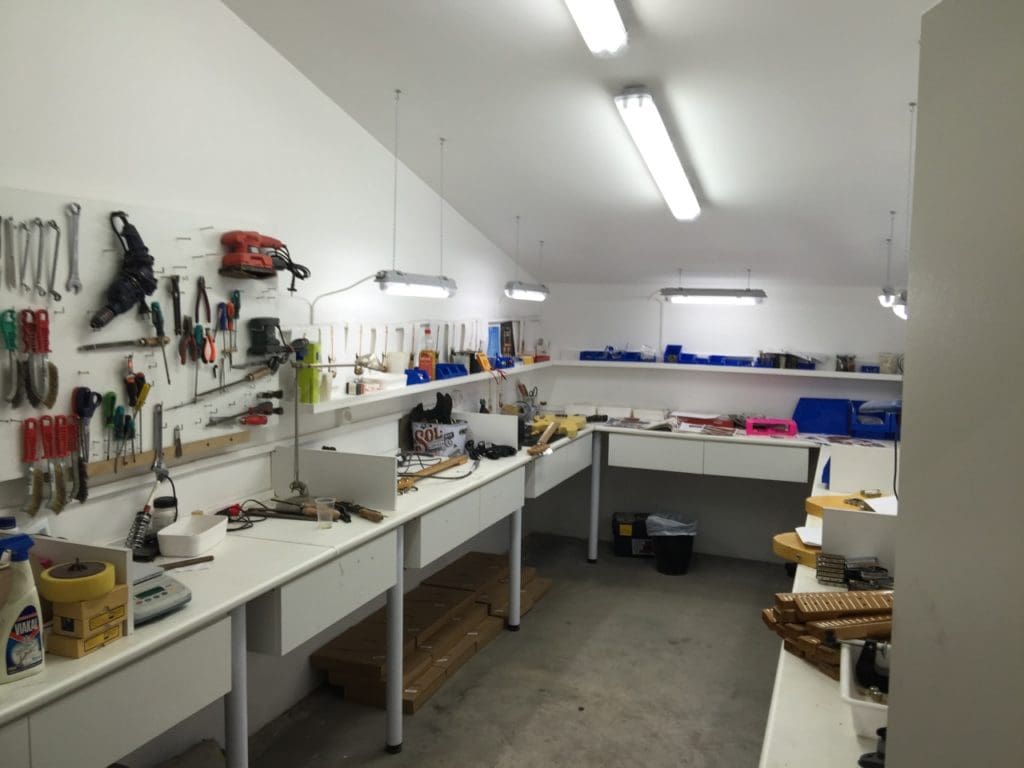
FJ: Do you have a personal “Holy Grail” guitar? That one instrument, that if you had to choose would be your one-and-only?
IB: Yes, I do, but I’m afraid that changes every other week! I have been collecting for almost 30 years and I am grateful enough to have had access to some phenomenal vintage pieces in my time. I mean the type of magical guitars that make you want to keep playing to become a better musician every day. Some of those guitars (mostly old Broadcasters, early Teles and Esquires) seem to have a soul of their own. They have unique voices and they interact with you while you play them. Just as if they had tenants living inside, like an old house with its own ghost in the attic, they inspire you to play things to a different level. They are not just another link in the chain. They have character and provide magic. You get that extra mojo bonus only great vintage guitars can deliver. This is not hype. Any player who has used vintage guitars extensively can relate to this. And I am not talking about a significant difference in tone you can hear. I am sure there are lots of new guitars out there that sound great. I don’t compare old to new guitars in those terms. And we all know a great player will always sound great no matter what he is using.
For me the vintage feel is not really about the sound you produce but how you bond with each instrument in a very special, joyful way. I have always thought vintage guitars make a real difference to the player but not so much to the average listener. They are a real treat, like portable pieces of music history… if only they could talk. They are pieces of art that you can admire but can also use as tools for making music.
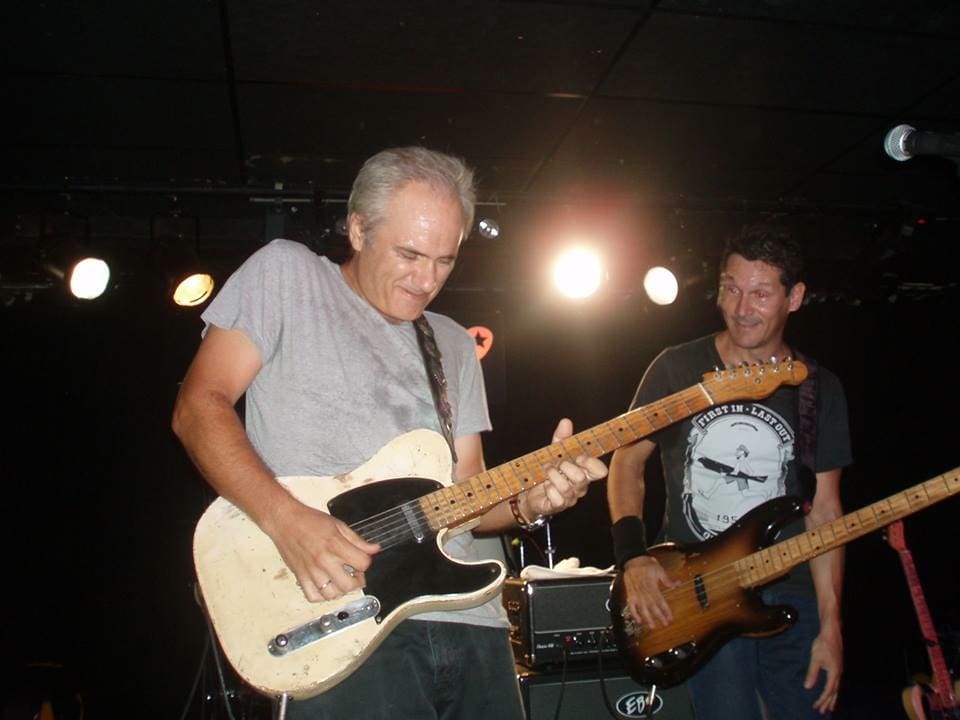
I bought my first Broadcaster (#0249) about 25 years ago while living in Boston, from Jimmy Brown’s Guitar Emporium in Louisville. Those were the times you had to wait for pics sent through snail mail, so when I received them, I called Jimmy right away. Much to my suprise, the guitar was already sold to GE Smith, who was a good customer of his. That Saturday night I was watching TV and saw GE playing the guitar on SNL. I kept staring at the pics and wanted to die. A few days later I called Jimmy again to ask to keep me posted on any other similar blackguard which may become available. Oddly enough, he confirmed GE had just returned the Broadcaster because it was too heavy for him. It was $4,500 so I sold all my gear and paid it off in three months. I still own it to this day.
I went to Boston University during 1992-94. My parents paid my lodging expenses. I figured I could save some money if I moved to a cheaper place. So I moved from a nice apartment in Kenmore Square to a funky basement on Beacon St. and shared the place with a friend. I was saving about $400 a month. Back then I could buy a vintage Fender every 3-4 months with that kind of money. So I started getting some cool pieces.
About 15 years ago, I was lucky enough to acquire Bill Hullet’s old Nocaster. It’s a really worn smoked-out player, pretty much original Holy Grail Blackguard. I have used that guitar extensively on records and gigs ever since.
I also own Broadcaster #0024, which I bought from my friend Jay Rosen and it’s very special.
There is Telecaster #1739 from September 1951, which I have owned for years and is very special too. Both Redd Volkaert and Billy Gibbons have used that guitar with me on stage and they both really loved it. It has got most of the body finish missing, but it looks, sounds and feels really great.
I really enjoy learning Chet Atkins fingerstyle picking. I have a couple of late 1940s ES-300s which are great, affordable and beautiful jazz boxes.
Although I’m more an electric player, I also love playing acoustic blues. I have a 1954 J-200, natural with double guard which sounds like a grand piano, and a very cool 1966 sunburst Hummingbird. I am not saying I don’t enjoy really great Martins, like the ones I try when I get to visit my friend Larry Wexer in NYC, but I am more of a Gibson guy when it comes to archtops, thinlines and acoustics.
Lately I have been acquiring some primitive electrics for the pinecaster book and found some of those to be really special, too. Things like a mid ‘30s Dobro all-electric, a National Electric and an electric Supro from the mid ‘30s, with those large patent pending pickups mounted onto the bridge. I also enjoy 1930s Vivitones, Slingerlands and early Rickenbachers.
I really enjoy all kinds of vintage guitars, but early Fender electrics are my pride and joy. They steal my heart and soul every day of the week. There is no comparable exciting experience than to open a thermometer case for the first time, with that smell filing the air, and to stare at a beautiful Blackguard in person for the first time… It’s a magic moment.
